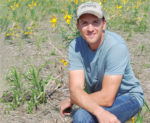Advertise Follow Us
Articles Tagged with ''drought''
Succeeding at No-Till Without ‘Chasing Acres’
After nearly quitting on agriculture, Jonathan Cobb is rebuilding his family’s central Texas farm through no-till practices, intense cover-crop mixes and rotational grazing to amass ‘soil wealth.’
Read More



.png?height=125&t=1731942302&width=150)





